One morning last fall, a rockslide crumbled down the side of Lookout Mountain that faces Chattanooga. This is not unusual for the area, but because of the persistent droughts that have become a staple in the summers, the sparking rocks rolled over bone-dry tinder on their way down. Within minutes, a fire sent a plume of black smoke into the sky.
I was in Detroit when I heard, spending a day in the Diego Rivera Hall at the art museum. Underneath his massive industrial frescos, I sat and looked at photos of the wildfire at home. In one image shared by the Chattanooga Times, the camera peered down the tracks of the Incline Railway where they disappeared into the fire, as if the city’s last operating streetcar was climbing straight out of hell.
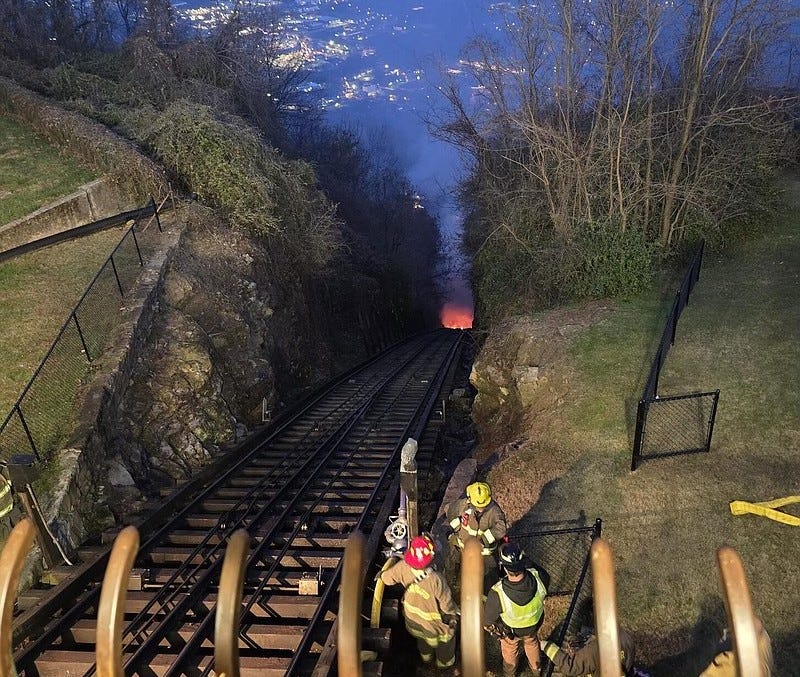
I lived with my mom on Lookout Mountain from ages 5 to 11. We didn’t use the Incline to commute there, although older people in the community tell me they remember taking it to school as kids. By the time I arrived, it had become a tourist attraction with no practical use beyond traveling from St. Elmo in the valley to Point Park at the peak. The latter was a Confederate stronghold in one of the more pivotal battles of the Civil War.
My dad got an apartment down the mountain on Cameron Hill. This happened to be where the Union army set up for that pivotal battle.
On weekends with him, our typical routine was parking somewhere downtown and then taking the free electric shuttle from the coffee shop to the library to the waterfront. The shuttle still runs, but it looks smaller than I remember.
Occasionally, I’ll take the city’s CARTA bus, which still requires an exact cash fare of $1.25, and whose union drivers are chatty with the passengers. When I step off after work, the bus driver tells me I’m sweet and to come back anytime. We rumble to a stop over defunct trolley tracks where they come up for air above the asphalt.
Just about 100 years ago, the vast majority of Chattanooga residents moved on these old tracks in state-of-the-art streetcars that took them to work, church, and shopping. Like most workers in the extremely union-dense city, the trolley carmen were organized: in 1899, they formally affiliated as Local 115 of the Amalgamated Association of Street Railway Employees of America (AASREA.)
The trouble started, according to James B. Jones, when the Chattanooga Light Rail Company introduced an automatic fare register to the cars. Instead of the driver personally collecting a fare from each passenger, he was now instructed to present this device, which would automatically count how much money was deposited.
The Light Rail Company called it a time-saver; but to the carmen, it was an insult. The workers protested the register, saying it made fare payments take even longer, and humiliated them with the implication that they couldn’t be trusted to collect fares without stealing.
Tensions mounted until August 20, 1917, when Local 115 voted to strike. The following weeks brought stories that feel unimaginable for modern-day Chattanoogans.
First, there was the solidarity from riders. Rather than complaining about the inconvenience, ordinary people were thrilled to join the boycott. They began a movement to commute on foot, wearing buttons that read “I Walk,” and causing overall ridership to drop 25%.
To break the strike, the Light Rail Company advertised in southern newspapers for new drivers. The scab drivers who arrived from surrounding states were described as “pugilists,” with a villainous, stocky build, and the walking would-be passengers identified them as enemies.
In another unbelievable display of working-class militancy, crowds of people swarmed around these scab-driven trolleys, aiming to drag the drivers out of their seats, as police desperately tried to intervene. The rioters smashed windows, derailed cars off their tracks, and in one instance, apparently swung a dead cat by the tail to attack the scabs. The crowd chanted: “Take them off! Pull him off! Cut the rope! Break in the doors! Kill them!”
Southerners tell our labor stories through Biblical allegories. As the streetcar strike of 1917 unfolded over days of riot and protest, the union won popular support by framing the conflict as a “battle between David and Goliath,” where local workers fought a massive company and the external forces it brought into Chattanooga.
At a series of community courthouse meetings, labor-sympathetic faith leaders stood with union representatives to address the masses. Rev. W.H. Briggs of St. Elmo Methodist Church declared that “Christ was a social democrat,” while Rev. Dr. E.L. Grace of Central Baptist Church equated strikers with “God’s Children,” and said that “in all questions of property vs. man, the human spirit must be paramount.”
The violent struggle reached a crescendo on August 23, 1917, when a scab driver fired a shotgun into a crowd of people attempting to derail his trolley. The shot killed a bystander: William Massengale, who worked at a brewery. Three days later, the strikers and community supporters poured into the streets to march for Massengale’s funeral, which had become a solidarity event, drawing over 1,200 people in silent protest.
Bosses and union leaders met to negotiate in earnest on the day of the funeral. They would continue to bargain until early October, when a tentative agreement brought the strike to an end. Jones recalled the celebratory spirit of that moment, especially in the working-class neighborhoods of East Chattanooga, where women brought fruit and flowers to the union drivers and laughed, cried, and cheered for their victory. Some former boycotters paid out their entire weekly wages as their fare.
Though the streetcar strike was a working-class victory, it was nearly derailed by racist divisions within the labor movement. As part of the tentative agreement, union workers demanded the Light Rail Company let go of its non-union staff, which included ten Black linemen in Chattanooga. It was true that the Black linemen had not participated in the strike, but they had never been invited by white workers to join the union in the first place. The question of their firing brought the white carmen to the edge of another strike, and the movement was only dissuaded when the secretary of the local Negro Barbers’ Union courageously spoke before the carmen. After R.B. Buckner of Local No. 460 made his appeal, the streetcar workers officially withdrew their contention that the Black linemen had been strikebreakers.
As I read about the 1917 strike, it’s hard to imagine this kind of class war taking place in contemporary Chattanooga. If our modern-day transit workers went on strike, would people boycott CARTA buses and walk downtown from the suburbs? If someone died on the line, would we all skip work and turn out in the streets for their funeral?
Sometimes it feels like the alienation is winning. Americans increasingly choose mocktails at home over social drinking, Netflix on the couch over collective movie theatre experiences, ordering groceries on an app over a trip to the store. With each tiny step back from public life, we lose another opportunity to know and care for one another, leaving a gap where social ties should grow.
Learning about the historic streetcar strikes also sheds light on the ongoing crisis of the National Labor Relations Board. Last month, Trump made a predictable move to oust Jennifer Abruzzo, the progressive General Counsel who had shaped the board into an effective platform for workers trying to organize on the job. In an unprecedented follow-up order, Trump also fired board members Jessica Rutter and Gwynne Wilcox, making it impossible to reach quorum.
If the NLRB cannot legally certify the results of union elections across the country, it leaves newly-organized workers like those at Whole Foods in Philadelphia hanging in uncertainty. Whole Foods CEO Jeff Bezos has already moved to challenge this union victory, and if he decides to illegally fire the organizers, they may have no recourse to get their jobs back.
Billionaires like Elon Musk have been working to dismantle the NLRB for years, and their victory will hurt the working class as a whole. Without the labor board, and the basic protections it affords unionizing workers, the contracts that unions have been bargaining with corporations for decades will become toothless.
In such a bleak moment for labor, it’s worth remembering that the Chattanooga streetcar strike took place before such an office existed. There is no legislation, no executive order, that can take away our ability to strike. Before the Labor Relations Act, setting down our tools and getting into the streets was the first and best weapon in the class war, and it’s something workers will return to in its absence. Labor militancy built this country, and if the billionaires want it back, we owe them a proper revival.
As read on the flyers for William Massengale’s 1917 funeral march: “Now is the time when all working people must stand together…show your sympathy with your own class and join the procession…Labor has declared a suspension of work for one day to attend this funeral, and if you are with your own class you will be there.”
Labor Intensive Recommendations
Dark Times Are Coming by Hamilton Nolan — a thorough explanation of the now and near future for labor.
Kholoud Hammad — an artist displaced from Northern Gaza makes incredible ballpoint pen drawings about Palestinian identity and liberation. You can buy risograph prints of the work to support her family.
Fascism as a Form of Self-Hatred by P.E. Moskowitz — an argument for the American death drive as the great mobilizer for the right.




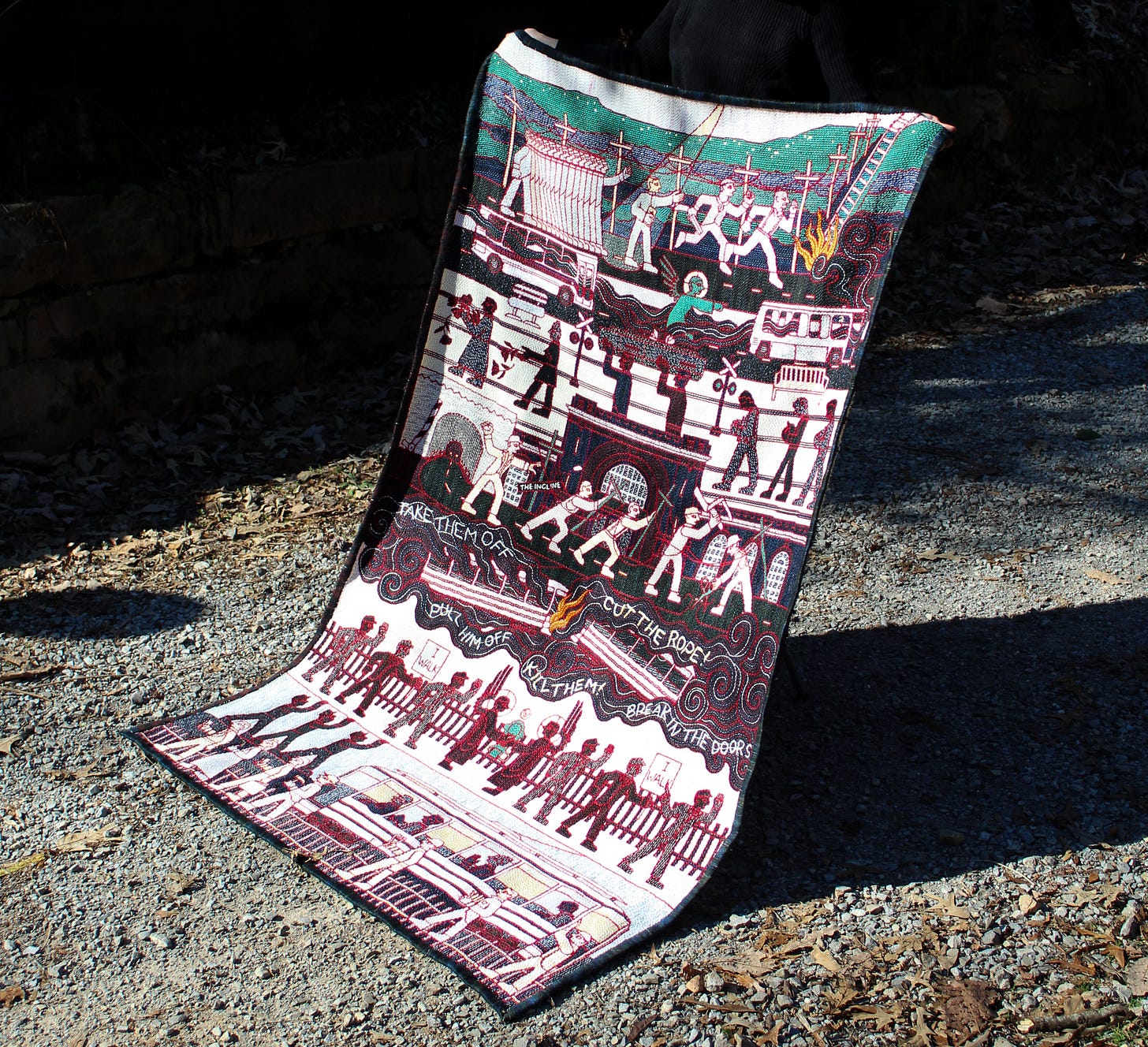
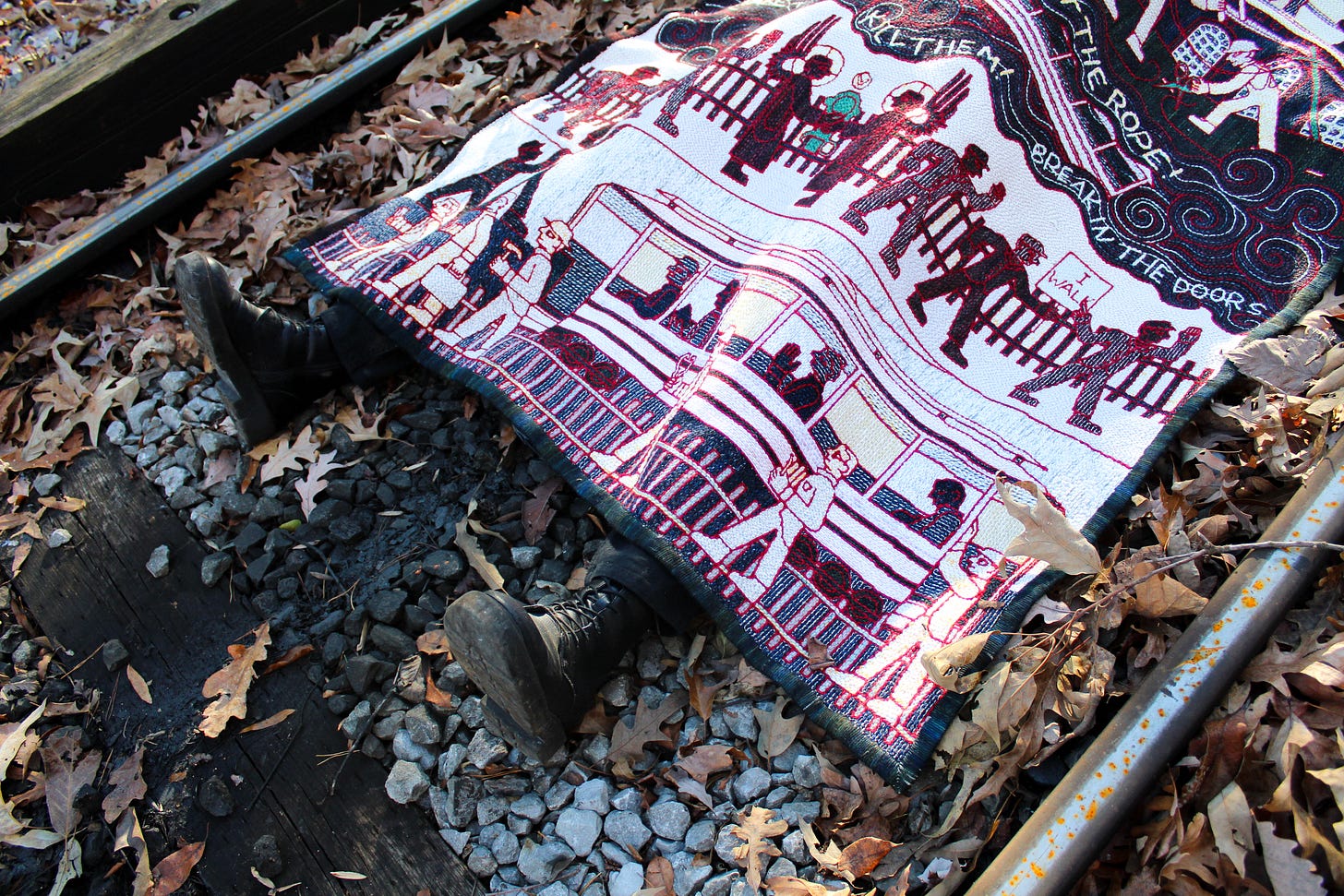
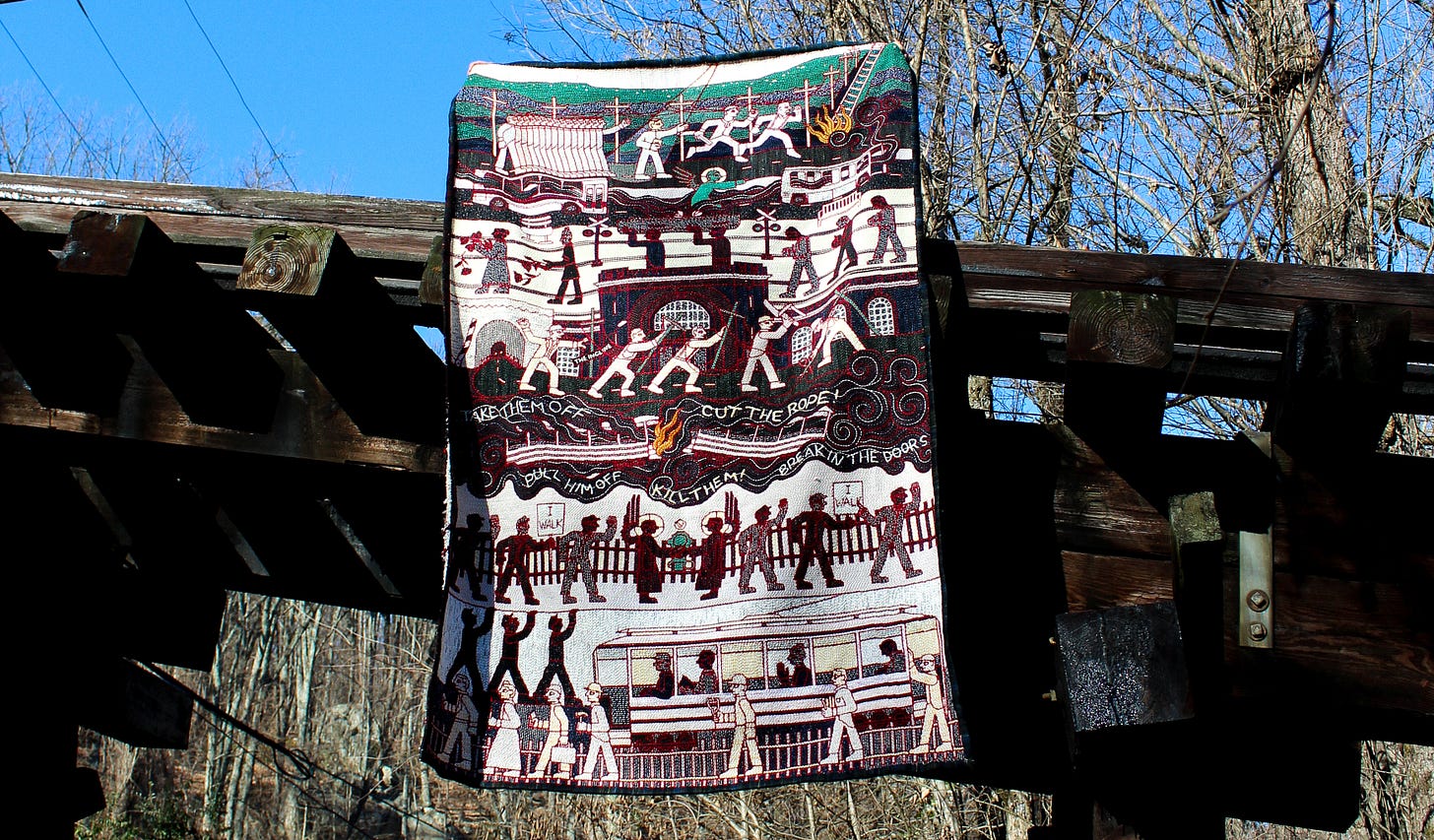
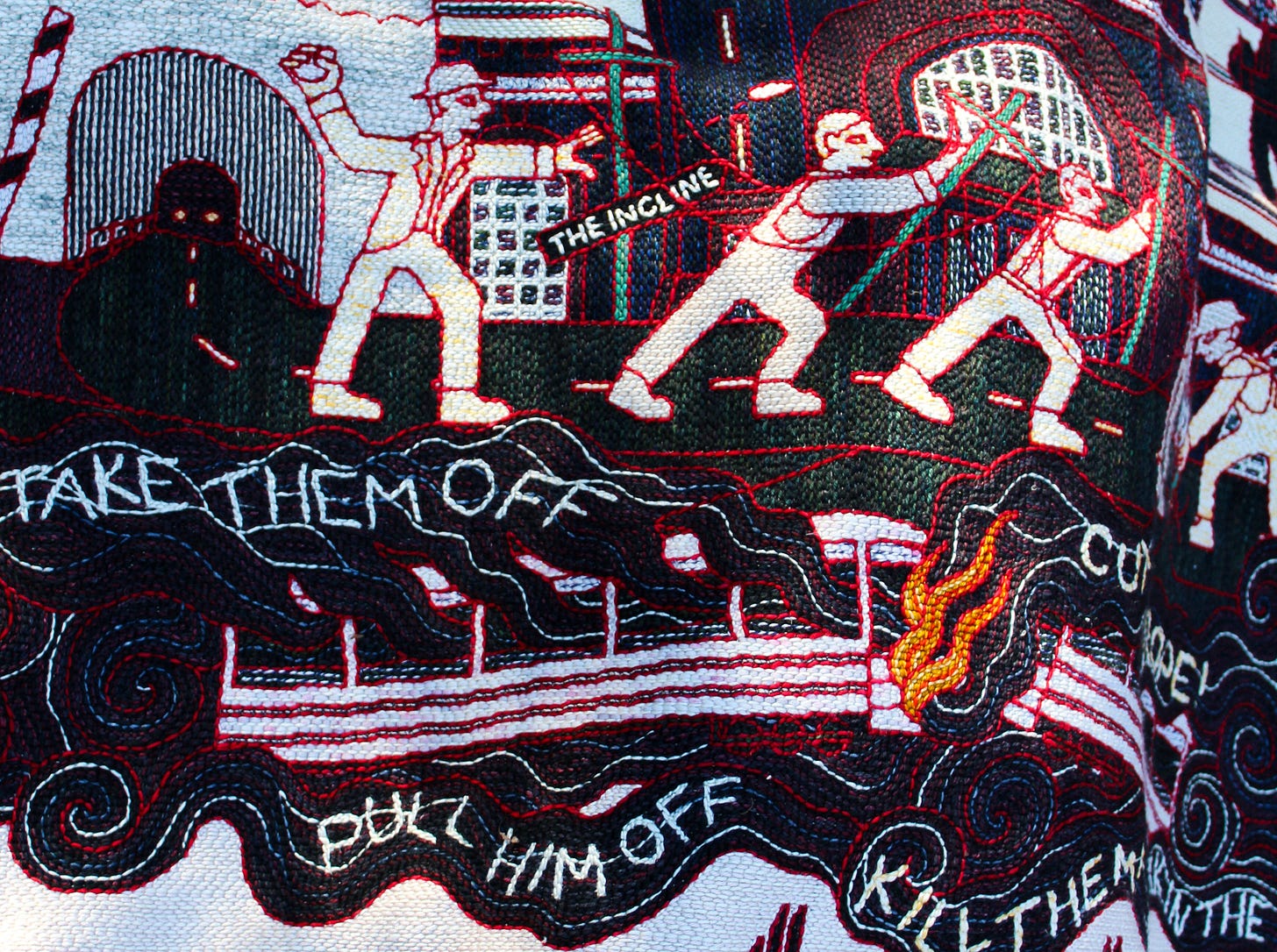
Your art and writing are thoughtful and evocative, bringing history to life in a way that connects the past with the present. Your reflections on Chattanooga’s labor history, public transit, and the fading communal spirit really resonated with me. I worked at Erlanger Medical Center for a while. I used to live in those apartments on Cameron Hill. Then I also lived on Shingle Road two doors down from the incline railway.
It’s powerful to think about how places change—not just physically, but in their rhythms of life and the way people move through them.
Reading your essay, I was reminded of my own time living near the Incline Railway, the same tracks you describe, and how much of Chattanooga’s history is layered into the geography itself. The story of the streetcar strike is one I hadn’t heard before, and it makes me wonder about the quiet struggles that shaped the city I once called home.
Thank you for sharing this piece. It’s a reminder that even in a world of growing individualism, there’s still space to remember, to walk, and to cross paths in meaningful ways. Looking forward to reading more of your work.
You writing is incredibly insightful. Don't lose hope. We lose every battle except the last one. Or in the words of David Lynch "Keep your eye on the donut, not on the hole"